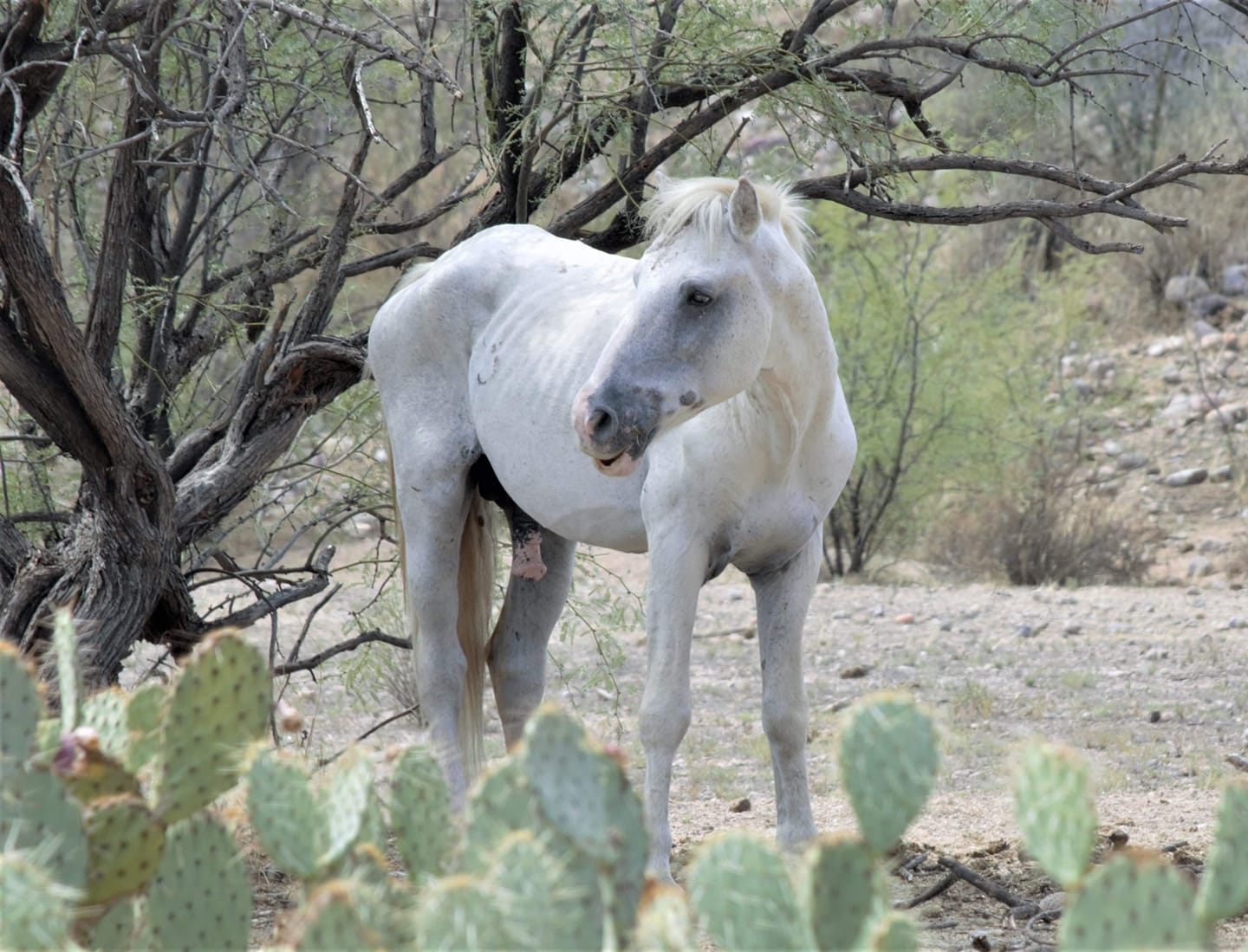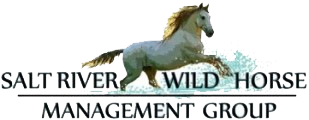
Humane management what does it mean?
In regards to injuries, it means assessing each case on an individual basis, carefully, and over time. When we observe an injury, sometimes it’s a quick clear decision, sometimes it may need a veteranary opinion, and sometimes, it is only time that will tell.
We document the case, we report it to AZDA and then we ask one or more volunteers to watch the injury every day thereafter, and note the progression of it; Is the injury or illness getting better or is it getting worse? A single moment snapshot at any point during the healing progress is rarely an accurate one. Would it not be a shame to euthanize a horse that has just beaten the worst point of his illness/injury?
Of course we also cannot forget that we are dealing with wild horses. Nature does not always look perfect. Everyone can understand that we cannot clean up wounds, bandage them, or provide antibiotics. (Antibiotic doses are too large for dart injection)
At the worst point of illness or injury in a wild horse, things can look pretty graphic sometimes and the situation may seem hopeless. In the past, for example, we have seen horses that in our opinion needed to be euthanized, only for them to disappear for months on end. Just after we had written them off in our database, they reappeared…completely healed.
There are a couple of these “miracle” horses still on the river today; one with a very crooked, but healed front leg, one with an enormous scar from his front leg to his withers, and also several that are half blind.
In a wild herd, injury happens far more often than is commonly known. So far in 2019, we have monitored 29 horses with some form of an injury, who all have survived. We have also monitored 9 horses who needed a merciful ending. If and when it is needed, humane euthanasia is a merciful and dignified ending, especially compared to what nature would do. As an example, our last case of humane euthanasia was Emerald. Please see our fb page for a video of her, and why rescue was not an option. Most other cases are detailed on our page as well.
Over the many years of management (both in an official and unofficial capacity), the amount of healing we have seen is truly incredible, to the point of “miraculous”. Because of these experiences, we have gained a high confidence in the capacity for healing in wild horses.
Their toughness originates with the principle of survival of the fittest. For many centuries, only the DNA of real survivors has contributed to this herd, without the help of mankind. If a wild horse cannot beat his/her infection, well then it dies. But the horse that beats the infection, gets to contribute its DNA for many years thereafter to the herd. So with each generation the herd gets stronger. This principle repeated generation after generation for centuries, results in some incredibly tough horses.
With our humane management protocols, this principal did not change. We do not take sick horses off the river to release them back to the herd. Every horse that we have rescued is no longer in the herd, which results in the same effect on the herd genetics as if they had died.
We rescue orphaned foals, and fatally injured horses, only to fix them up and provide them a happy life with a family, at either one of our facilities. (One where we keep the horses that need more intensive care and the other for horses that are healed and just get to roam.) We will and do consider sanctuary situations for them, but it’s very hard to place horses in sanctuary situations as most of them are full.
You, the public, are a large part of making humane management principles work. You contribute when we are in need and also you sponsor any of our rescues, on srwhmg.org so that they may live happily ever after.
With more funds of course we can do more good!
Skinny horses:
We strive for a body score of 4 (See henneke scale) but we have a small percentage of horses that fall below that perfect body score and also a few that are leaning the other way towards “plain fat”.
The reasons for a poorer body condition can be:
1. Older horses; They also have a lot less muscle, so they are not strong in appearance and will likely never get there again. Approximately 4% of horses in the herd are over the age of 18.
2. Mares who are nursing both a yearling and foal. Some mares are not very strict and we see them let both their yearlings as well as newborns nurse from them.
3.Yearlings recently cut off from their milk supply by strict mothers. A few yearlings seem to have a hard time when their mothers deny them the milk they are used to, because the new foal needs the milk more than they do. These yearlings always grow out of this phase quickly.
4. Mares that have recently lost a foal. Each time that a mare loses a foal, we see their body condition go down immediately afterwards, this will usually be 2 to 3 months until she gains it back. We believe this weight loss may be related to pure grief.
5. Horses that are sick or have an injury: When we see a skinny horse, we immediately check for sickness or injury since it is a strong indicator that something is wrong if the rest of their band looks healthy.
6. Mares too young to have a foal: Our birth control program was authorized in October of last year. This was too late to prevent any 2019 births. We have mares that gave birth at only 2 years of age. Those mares barely got to grow into their own bodies before having to nurse a newborn. These mares we see having a hard time as well.
However, the majority of the herd is in good body condition at this time and we do not believe wild horses should be fed until they are fat.
Our feed program is in full swing, going as planned with great results. We do not see it ending soon, as the monsoon seems more like a nonsoon this year.
Our feed program is the reason we have been asking for donations and our supporters have been there for the horses. We spend approximately $7000 to $7500 (depending on marketprices) every 3 to 4 weeks on a new truckload of hay. That does not count indirect expenses, such as tools and equipment.
We spend hundreds of volunteer hours per week getting the alfalfa to the horses in extreme temperatures.
The horses still have other resources as well such as the mesquite trees and the river eelgrass, which they still naturally eat, even with the feed we provide.
Getting back to Shadowfax,
here he is in this picture taken yesterday. We know he does not look pretty right now. We are managing a natural system which does not always look as perfect as we wish it to. These horses are wild and that is part of why we all love them so much.
From our extensive and longtime experience with wild horses, as well as in our veterinarian’s experience, the odds of Shadowfax beating this illness are good. He has pep in his step, joy for life in his eyes and even now, he takes care of his family first.
We are anxiously awaiting the results of the culture, should it be the strangles bacteria we will immediately take the appropriate measures and send out alerts as well as post them in the area.
Humane management does mean making hard decisions sometimes. It means working with and sometimes against nature, but it also means giving nature a chance. It is about finding the balance.
So let’s not criticize the imperfectness of nature, but most of all, let’s never underestimate the power of it.
With his daily visible improvements, is our hope that this beautiful, weathered old lead stallion, will soon prove his many internet naysayers wrong.
Go Shadowfax!
Respectfully, SRWHMG.
